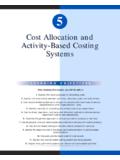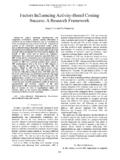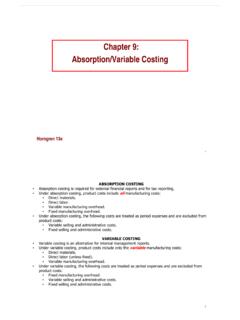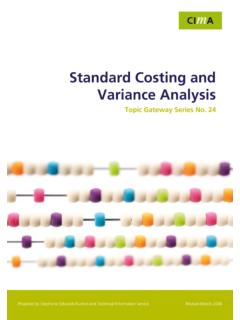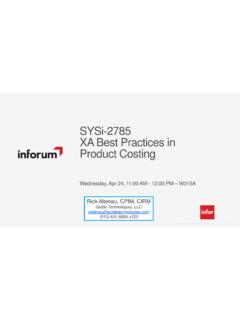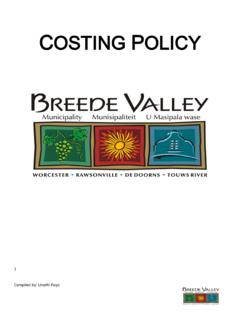Transcription of Delivering Effi ciency: Understanding the Cost of Local ...
1 Delivering Effi ciency : Understanding the Cost of Local Government , opportunity, prosperityDelivering Effi ciency : Understanding the Cost of Local Government ServicesInstitute of Public Finance (IPF)North West e-Government Group (NWeGG)March 2008 Communities and Local Government: LondonDepartment for Communities and Local GovernmentEland HouseBressenden PlaceLondon SW1E 5 DUTelephone: 020 7944 4400 Website: Queen s Printer and Controller of Her Majesty s Stationery Offi ce 2008 Copyright in the typographical arrangement rests with the publication, excluding logos, may be reproduced free of charge in any format or medium for research, private study or for internal circulation within an organisation.
2 This is subject to it being reproduced accurately and not used in a misleading context. The material must be acknowledged as Crown Copyright and the title of the publication specifi other use of the contents of this publication would require a copyright licence. Please apply for a Click-Use Licence for core material at or by writing to the Offi ce of Public Sector Information, Information Policy Team, St Clements House, 2-16 Colegate, Norwich NR3 1BQ. Fax: 01603 723000 or email: you require this publication in an alternative format please email and Local Government PublicationsPO Box 236 WetherbyWest YorkshireLS23 7 NBTel: 0870 1226 236 Fax: 0870 1226 237 Textphone: 0870 1207 405 Email: online via the Communities and Local Government website: 2008 Product Code: 07 LGSR 05119 Delivering Effi ciency .
3 Understanding the Cost of Local Government Services | 3 Contents Foreword 5 Executive summary 6 How to use this report 9 Chapter 1 Costs allocation framework 10 Research methodology costing of processes 11 Current approaches to costing 12 How has ABC been used to date? 13 Why activity based costing ? 13 costing options in relation to activity based costing 14 Activity based costing basic methodology 15 Rationale 15 Targeting effi ciencies 16 Chapter 2 Using costing methods 18 Issues and choices 19 Option 1 Top down approach 19 Option 2 ABC based on staffi ng costs 20
4 Option 3 Additional costs or overheads 20 Option 4 Transparent fully devolved cost responsibilities 23 Cost architecture model basic principles 24 Benchmarking issues to consider when using the costs architecture model 25 Summary 26 Chapter 3 What to consider when choosing a costing methodology 28 Which option to use?
5 28 Ensuring staff buy-in 29 Some issues to consider in applying the cost architecture model 30 External sources and advice 31 Chapter 4 The costs architecture model 32 What does the cost architecture comprise? 33 A list of LA functions (inc. the statutory duties and powers) 33 The Local government service list 34 Processes (units of work) 34 A starter for 10 list of activities 354 | Delivering Effi ciency : Understanding the Cost of Local Government Services Why is this approach useful?
6 35 What does the transaction look like? 35 Worked example 37 Functions 37 Associated services from LGSL 37 Typical processes 38 Typical activities 39
7 Conclusions 41 Annex 1 Accountancy defi nitional details 42 Structure of the subjective analysis 42 Guidance relating to the recharging of overheads to services as part of Best Value Accounting Code of Practice (BVACOP) 45 Annex 2 Organisations contacted as part of research 47 Annex 3 Questions from workshop held 48 A summary of the results collected 50 Annex 4 Benefi ts of an activity based costing approach 56 Benefi ts to Local authority management 56 Benefi ts to Local authority members (policy and scrutiny) 57 Benefi ts to central government and other agencies 58 Annex 5 The Local government transaction list 59 Delivering Effi ciency .
8 Understanding the Cost of Local Government Services | 5 ForewordRe-designing Local services to meet the needs of Local people is a constant challenge. It is a challenge which can only be met by strong leadership and good partnership working at Local level. Central Government can help by creating the right framework for Local partnership and supporting the development of new tools and report is an important step forward in helping Local authorities to identify the costs of providing services, allowing comparisons and supporting work to achieve greater value for money.
9 The report draws on the work already undertaken on Validated Service Delivery Costs1 by the North-West e-Government Group (NWEGG), and links to outputs from the National Process Improvement Project (NPIP). Making clear connections between costs and service outputs reveals the true potential for value for money savings, particularly in relation to back offi ce business process improvement and in recognising the cost of Delivering service transactions through different access November, we published our new business improvement guide,2 containing practical advice and examples of redesigning services to increase overall performance and cost effectiveness.
10 The publication of this new report by NWEGG/IPF should be seen as a companion piece to the business improvement guide. The outputs presented here include a common costs allocation framework for calculating the costs of business processes and a standard defi nition of what constitutes a Local government the public sector, citizens increasingly and rightly expect good value for money. In Local Authorities, this goes beyond satisfying central government or getting that tick from the Audit Commission. Rather, it is about managing service delivery costs more effectively to provide resources for the front line and to keep council tax pressures down.

